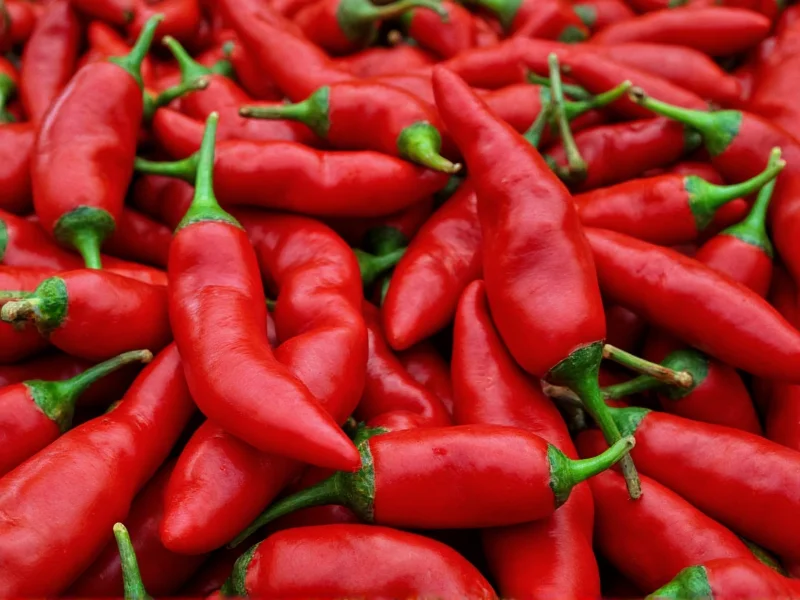Understanding chili heat levels is essential for both culinary enthusiasts and casual cooks. The Scoville Organoleptic Test, developed by pharmacist Wilbur Scoville in 1912, remains the standard measurement for capsaicin concentration—the compound responsible for chili heat. While modern high-performance liquid chromatography provides more precise measurements, Scoville Heat Units (SHU) remain the consumer-friendly benchmark for comparing chili pepper intensity.
How the Scoville Scale Works
The original Scoville method involved diluting chili extract in sugar water until the heat became undetectable to a panel of tasters. A 1,000 SHU rating meant the extract required 1,000 parts of sugar water to neutralize the heat. Today's laboratory methods convert capsaicin measurements into equivalent Scoville units, maintaining consistency with historical data.
It's crucial to understand that SHU values represent ranges rather than fixed numbers. Environmental factors like soil composition, climate, and cultivation practices significantly impact a pepper's actual heat level. A jalapeño grown in New Mexico might register 8,000 SHU, while the same variety from California could measure only 2,500 SHU.
Complete Chili Pepper List by Scoville Heat Units
Below is the definitive reference for chili heat levels, organized from mildest to hottest. This comprehensive scoville scale chart includes both common supermarket varieties and extreme superhots for adventurous eaters.
| Chili Pepper | Scoville Heat Units (SHU) | Heat Level Description | Common Culinary Uses |
|---|---|---|---|
| Bell Pepper | 0 SHU | No heat | Salads, stuffed peppers, stir-fries |
| Pepperoncini | 100-500 SHU | Mild tangy | Greek salads, sandwiches, antipasti |
| Poblano | 1,000-2,000 SHU | Very mild | Chiles Rellenos, mole sauce, roasted dishes |
| Anaheim Pepper | 500-2,500 SHU | Mild | Southwestern cuisine, green chile stew |
| Jalapeño | 2,500-8,000 SHU | Moderate heat | Salsas, nachos, pickled peppers, poppers |
| Serrano | 10,000-23,000 SHU | Medium-hot | Pico de gallo, hot sauces, guacamole |
| Cayenne | 30,000-50,000 SHU | Hot | Spice blends, Cajun cuisine, dried flakes |
| Tabasco | 30,000-50,000 SHU | Hot | Tabasco sauce, marinades, bloody marys |
| Thai Bird's Eye | 50,000-100,000 SHU | Very hot | Thai curries, Southeast Asian dishes |
| Habanero | 100,000-350,000 SHU | Extremely hot | Caribbean sauces, hot sauces, salsas |
| Scotch Bonnet | 100,000-350,000 SHU | Extremely hot | Jamaican jerk seasoning, Caribbean cuisine |
| Ghost Pepper (Bhut Jolokia) | 800,000-1,041,427 SHU | Superhot | Extreme hot sauces, chili challenges |
| Trinidad Moruga Scorpion | 800,000-2,000,000 SHU | Superhot | Specialty hot sauces, culinary challenges |
| Carolina Reaper | 1,400,000-2,200,000 SHU | World's hottest (formerly) | Commercial hot sauces, extreme challenges |
| Pepper X | 2,200,000-3,180,000 SHU | World's hottest (current) | Experimental hot sauces, record attempts |
Practical Applications of the Scoville Scale
Understanding scoville heat units for cooking transforms your culinary experience. When substituting peppers in recipes, consider these practical guidelines:
- Mild cooking (0-5,000 SHU): Ideal for dishes where pepper flavor should shine without overwhelming heat. Bell peppers and poblanos work well in stuffed dishes and roasted vegetable medleys.
- Moderate heat (5,000-30,000 SHU): Perfect for everyday cooking. Jalapeños add noticeable heat to salsas without dominating other flavors. Remove seeds and membranes to reduce heat by up to 80%.
- High heat (30,000-100,000 SHU): Use sparingly in hot sauces and specialty dishes. A single cayenne pepper can flavor an entire pot of chili. Always wear gloves when handling.
- Extreme heat (100,000+ SHU): Handle with extreme caution. Habaneros and hotter varieties require careful measurement—often just a few drops of infused oil suffice. Never breathe directly over cut superhot peppers.
Safety Considerations with High-Scoville Peppers
Working with high-heat chilies demands proper precautions. Capsaicin, the compound measured by scoville units, is oil-based and doesn't wash away with water. When handling extremely hot peppers:
- Always wear nitrile gloves (latex won't protect you)
- Avoid touching your face, especially eyes and nose
- Work in well-ventilated areas to avoid inhaling capsaicin particles
- If burned, use milk, yogurt, or oil to neutralize the heat—not water
- Never use blenders with superhots without proper ventilation
Medical professionals report increasing cases of "ghost pepper burns" requiring emergency treatment. The current record holder, Pepper X, contains enough capsaicin that accidental contact with skin can cause chemical burns.
Common Misconceptions About the Scoville Scale
Several myths persist about scoville heat measurement:
- Myth: The Scoville scale measures temperature
Reality: It measures capsaicin concentration, not actual temperature - Myth: SHU values are precise measurements
Reality: They represent ranges due to natural variation in pepper heat - Myth: Color indicates heat level
Reality: A green habanero can be hotter than an orange one of the same variety - Myth: Seeds contain the most heat
Reality: The placenta (white membrane) holds most capsaicin; seeds absorb heat from contact
Understanding Regional Variations in Chili Heat
The same chili variety can exhibit dramatic heat differences based on growing conditions. This phenomenon explains why:
- Mexican-grown jalapeños often exceed 8,000 SHU while California varieties stay below 5,000 SHU
- Stress factors like drought increase capsaicin production as a defense mechanism
- Soil composition affects nutrient availability, influencing heat development
- Altitude impacts temperature fluctuations that affect capsaicin synthesis
When following recipes that specify particular chilies, consider your local variety's typical heat range. A "mild" habanero from your farmers market might match the heat of an average jalapeño from another region.
Measuring Heat Beyond the Scoville Scale
While the scoville scale remains popular, food scientists increasingly use ASTA pungency units and high-performance liquid chromatography (HPLC) for precise capsaicin measurement. These methods provide objective data without human taste variation. One ASTA unit equals approximately 15 Scoville units, creating a standardized conversion.
Emerging research explores the Scoville scale's limitations, particularly for superhot peppers where the human palate cannot distinguish between extreme heat levels. New measurement techniques focus on specific capsaicinoid compounds rather than overall heat perception.











 浙公网安备
33010002000092号
浙公网安备
33010002000092号 浙B2-20120091-4
浙B2-20120091-4